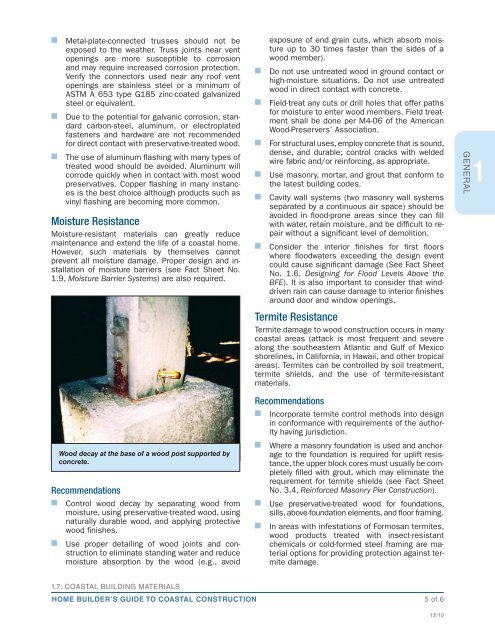FEMA P-499: Home Builder's Guide to Coastal Construction
FEMA P-499: Home Builder's Guide to Coastal Construction
FEMA P-499: Home Builder's Guide to Coastal Construction
You also want an ePaper? Increase the reach of your titles
YUMPU automatically turns print PDFs into web optimized ePapers that Google loves.
n Metal-plate-connected trusses should not be<br />
exposed <strong>to</strong> the weather. Truss joints near vent<br />
openings are more susceptible <strong>to</strong> corrosion<br />
and may require increased corrosion protection.<br />
Verify the connec<strong>to</strong>rs used near any roof vent<br />
openings are stainless steel or a minimum of<br />
ASTM A 653 type G185 zinc-coated galvanized<br />
steel or equivalent.<br />
n Due <strong>to</strong> the potential for galvanic corrosion, standard<br />
carbon-steel, aluminum, or electroplated<br />
fasteners and hardware are not recommended<br />
for direct contact with preservative-treated wood.<br />
n The use of aluminum flashing with many types of<br />
treated wood should be avoided. Aluminum will<br />
corrode quickly when in contact with most wood<br />
preservatives. Copper flashing in many instances<br />
is the best choice although products such as<br />
vinyl flashing are becoming more common.<br />
Moisture Resistance<br />
Moisture-resistant materials can greatly reduce<br />
maintenance and extend the life of a coastal home.<br />
However, such materials by themselves cannot<br />
prevent all moisture damage. Proper design and installation<br />
of moisture barriers (see Fact Sheet No.<br />
1.9, Moisture Barrier Systems) are also required.<br />
Wood decay at the base of a wood post supported by<br />
concrete.<br />
Recommendations<br />
n Control wood decay by separating wood from<br />
moisture, using preservative-treated wood, using<br />
naturally durable wood, and applying protective<br />
wood finishes.<br />
n Use proper detailing of wood joints and construction<br />
<strong>to</strong> eliminate standing water and reduce<br />
moisture absorption by the wood (e.g., avoid<br />
1.7: COASTAL BUILDING MATERIALS<br />
exposure of end grain cuts, which absorb moisture<br />
up <strong>to</strong> 30 times faster than the sides of a<br />
wood member).<br />
n Do not use untreated wood in ground contact or<br />
high-moisture situations. Do not use untreated<br />
wood in direct contact with concrete.<br />
n Field-treat any cuts or drill holes that offer paths<br />
for moisture <strong>to</strong> enter wood members. Field treatment<br />
shall be done per M4-06 of the American<br />
Wood-Preservers’ Association.<br />
n For structural uses, employ concrete that is sound,<br />
dense, and durable; control cracks with welded<br />
wire fabric and/or reinforcing, as appropriate.<br />
n Use masonry, mortar, and grout that conform <strong>to</strong><br />
the latest building codes.<br />
n Cavity wall systems (two masonry wall systems<br />
separated by a continuous air space) should be<br />
avoided in flood-prone areas since they can fill<br />
with water, retain moisture, and be difficult <strong>to</strong> repair<br />
without a significant level of demolition.<br />
n Consider the interior finishes for first floors<br />
where floodwaters exceeding the design event<br />
could cause significant damage (See Fact Sheet<br />
No. 1.6, Designing for Flood Levels Above the<br />
BFE). It is also important <strong>to</strong> consider that winddriven<br />
rain can cause damage <strong>to</strong> interior finishes<br />
around door and window openings.<br />
Termite Resistance<br />
Termite damage <strong>to</strong> wood construction occurs in many<br />
coastal areas (attack is most frequent and severe<br />
along the southeastern Atlantic and Gulf of Mexico<br />
shorelines, in California, in Hawaii, and other tropical<br />
areas). Termites can be controlled by soil treatment,<br />
termite shields, and the use of termite-resistant<br />
materials.<br />
Recommendations<br />
n Incorporate termite control methods in<strong>to</strong> design<br />
in conformance with requirements of the authority<br />
having jurisdiction.<br />
n Where a masonry foundation is used and anchorage<br />
<strong>to</strong> the foundation is required for uplift resistance,<br />
the upper block cores must usually be completely<br />
filled with grout, which may eliminate the<br />
requirement for termite shields (see Fact Sheet<br />
No. 3.4, Reinforced Masonry Pier <strong>Construction</strong>).<br />
n Use preservative-treated wood for foundations,<br />
sills, above-foundation elements, and floor framing.<br />
n In areas with infestations of Formosan termites,<br />
wood products treated with insect-resistant<br />
chemicals or cold-formed steel framing are material<br />
options for providing protection against termite<br />
damage.<br />
HOME BUILDER’S GUIDE TO COASTAL CONSTRUCTION 5 of 6<br />
12/10<br />
GENERAL<br />
1


